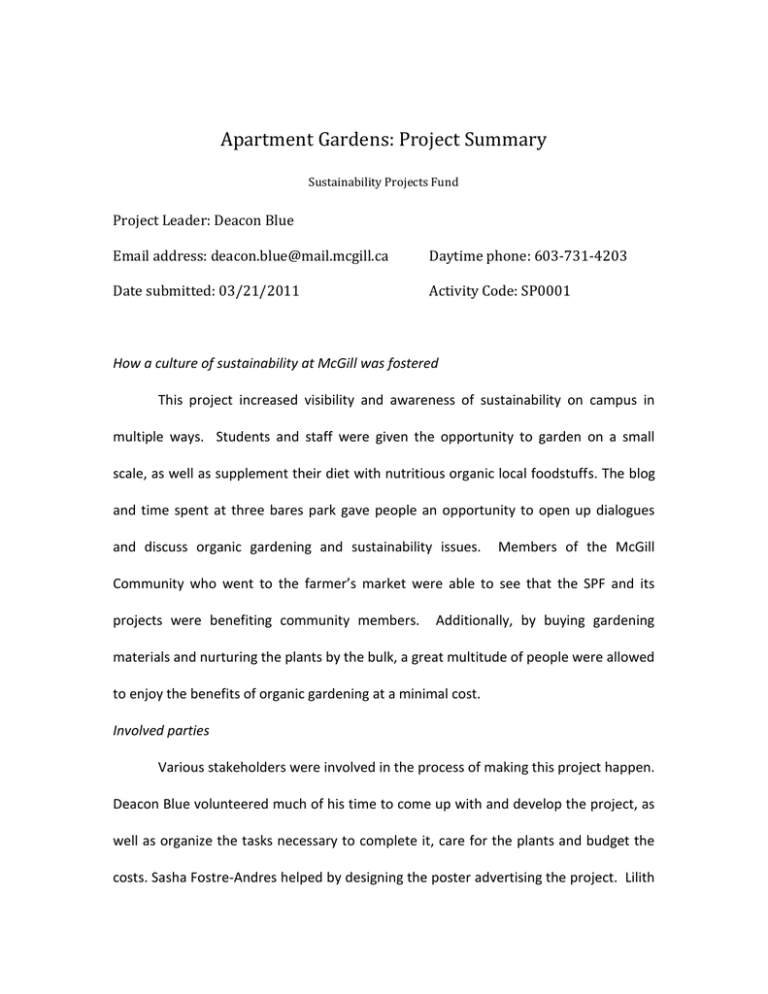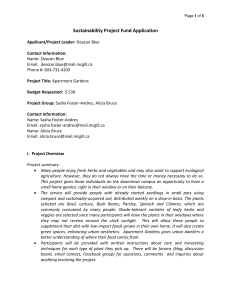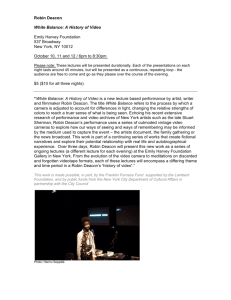Apartment Gardens: Project Summary
advertisement

Apartment Gardens: Project Summary Sustainability Projects Fund Project Leader: Deacon Blue Email address: deacon.blue@mail.mcgill.ca Daytime phone: 603-731-4203 Date submitted: 03/21/2011 Activity Code: SP0001 How a culture of sustainability at McGill was fostered This project increased visibility and awareness of sustainability on campus in multiple ways. Students and staff were given the opportunity to garden on a small scale, as well as supplement their diet with nutritious organic local foodstuffs. The blog and time spent at three bares park gave people an opportunity to open up dialogues and discuss organic gardening and sustainability issues. Members of the McGill Community who went to the farmer’s market were able to see that the SPF and its projects were benefiting community members. Additionally, by buying gardening materials and nurturing the plants by the bulk, a great multitude of people were allowed to enjoy the benefits of organic gardening at a minimal cost. Involved parties Various stakeholders were involved in the process of making this project happen. Deacon Blue volunteered much of his time to come up with and develop the project, as well as organize the tasks necessary to complete it, care for the plants and budget the costs. Sasha Fostre-Andres helped by designing the poster advertising the project. Lilith Wyatt was instrumental in helping to develop the project as well as acting as a liaison between the SPF and Apartment Gardens. Arlene Throness and the rest of the people at Concordia rooftop organic greenhouses made it possible to have a space for the plants to be grown in by allowing volunteer time spent there to be traded for the use of their space. The McGill Farmer’s Market were very generous in giving space for the plants to be distributed every week. How goals of the project were met The progression of the project went as planned, however there were some temporal and logistical changes that had to be made in order to adapt to unforeseen challenges. Over fifty people received one or two plants, all of whose names and emails were recorded such that they could be sent information regarding the blog and plastic pot collection. The project was originally planned out to start planting in May and distribute plants in June and July, however it was determined that not enough people were on campus at those times and little success and visibility would be attained. As a result, seeding was pushed back to late June and plants were handed out in September and October, when more people would be around for the fall semester and the Farmer’s Market would have started. This also meant that instead of having two seeding periods, plants were prepared for early autumn. Only about twenty of sixty some pots were collected in October, and thus some participants presumably couldn’t find the time to return them and must have kept them. Perhaps in the future either the plants could be sold for a minimal cost, or a deposit could be put down for the pot, and returned upon reception of the pot later on. The rest of the tasks that went along with the project (posters, blog, etc.) were also pushed back as a result of how things progressed. Many plants (thin leaved ones like lettuce, spinach and beans) were unfortunately the victims of bug infestations due to the organic nature of the greenhouse and project, and were thus not handed out because people aren’t very enticed by eating bugs and ‘ugly’ plants. Accountability Apartment gardens has potential to be an effective economically sustainable project. In its first year, plants were handed out free of charge and students were very excited about the chance to garden. Materials were relatively inexpensive considering the impact that the project had, as seen in the budget below. The volunteer work was however very demanding, requiring many hours per week spent on tasks such as watering and tending to plants. It may be more effective to therefore pay the workers of the project, funded by charging a couple of dollars for each plant, which is still much less expensive than if you were to buy plants at a farmer’s market or supermarket. If enough plants were produced and sold, the supplies could also possibly be at least partially paid for, and the project would be of little cost to the Sustainability Projects Fund. There is potential for this project to get some additional funds if the plants were sold rather than given away, and if more plants were propogated. This year, only sixty some odd plants were distributed, and at two dollars a pot would have paid for half of the project cost. It took very little time distributing plants at the farmer’s market for the them all to be handed out, and was done over only two weeks. The controlling factor was most certainly supply, and if many plants were grown then they could be handed out over six weeks and throughout the day, thus positively impacting a greater quantity of people. It would be feasible to produce and distribute upwards of five hundred plants. Institutionalization There is vast potential for carrying this project into the future and it would be a nice yearly tradition for returning students and staff. Logistically, it was not terribly complicated to run the project and although the project coordinator may not be able to indefinitely carry on the project, it could easily be passed on to another community member to be managed and continued in the years to come. What was learned Apartment Gardens has offered lessons about localized food sources, people’s opinions about sustainability issues, urban agriculture, small project management and much more. By employing organic methods and localizing food production, resources like oil, water, electricity, chemicals and more were conserved and left almost entirely out of the production process. The challenges posed by urban agriculture in a rooftop greenhouse and people’s apartments were confronted head-on, and many lessons were taken from this process. Discussions were constantly being held with various stakeholders in the project, and people’s thoughts, questions and opinions were always considered as things moved on. The project had many management tasks such as financing, task organization, and coordination with the administration. There are still many interesting investigations and lessons to be learned pertaining to this project into the future. Budget The original budget for the project was as follows: Expense Description Estimated Cost Sustainably sourced peat moss/organic soil (6 bags) $ 15 * 6 bags = $ 90 Square four inch recyclable plastic pots $ 1 * 120 pots = $ 120 Seeds mail ordered from Johnny’s Selected (6 varieties, 1 packet each) $ 5 * 6 = $ 30 Organic nutrients (compost, organic nitrogen) $ 40 Transportation costs (gasoline), promotional poster printing, tabling $ 20 + $ 20 + $ 10 = $ 50 Grand total $ 330 The budget ended up being a bit less than what was originally estimated. The soil was significantly less than originally estimated. After shopping around, cheaper pots were found than the original quote that was given. Nutrients cost a bit more than originally thought. Posters and other costs ended up being a good deal less than first quoted. Additionally, cheap stakes needed to be purchased for the bush beans. The actual expenses for the project were as follows: Expense Description Cost Organic soil mix (black earth, peat moss, vermiculite) $ 49.50 Square six inch recyclable plastic pots $ 56.43 Seeds mail ordered from Johnny’s Selected (6 varieties, 1 packet each) $ 33.95 Organic nutrients and mycorrhizae $ 74.92 Promotional poster printing $ 20.00 Bamboo stakes $ 5.63 Total $ 240.13 Hours The original estimation for the hours to be spent for the project were as follows: Type of Activity – Task Estimated Time Required Group Member in Charge Acquisition of materials 4 hours Deacon Preparation of seedlings 5 hours * 2 seedings = 10 hours Deacon Weekly distribution 5 hours * 15 weeks = 75 hours Whole Group Pickup of used pots 1 hours * 8 weeks = 8 hours Whole Group Correspondence and promotion 2 hours * 20 weeks = 40 hours Whole Group Total Hours Whole Group 137 hours The actual number of hours spent on the project differed in a few ways, most notably that a lot of time was spent on watering the plants and upkeep of the greenhouse space and plants. Acquisition of materials also took longer than originally thought. Although there were not two seeding periods as thought, they were planted in a staggered fashion and ended up taking about as long as was originally thought. Weekly distribution only occurred over the course of two non-consecutive weeks in September and October, as plants were ready, and thus took much less time than thought. The actual hours for the project were as follows: Type of Activity – Task Estimated Time Required Group Member in Charge Acquisition of materials 7 hours Deacon Preparation of seedlings 3 hours * 3 seedings = 9 hours Deacon Weekly distribution 5 hours * 2 weeks = 10 hours Deacon Pickup of used pots 1 hours * 8 weeks = 8 hours Deacon Correspondence and promotion 2 hours * 16 weeks = 32 hours Sasha and Deacon Watering and upkeep 4 hours * 12 weeks = 48 hours Deacon Total Hours 114 hours Deacon (114), Sasha (2)

